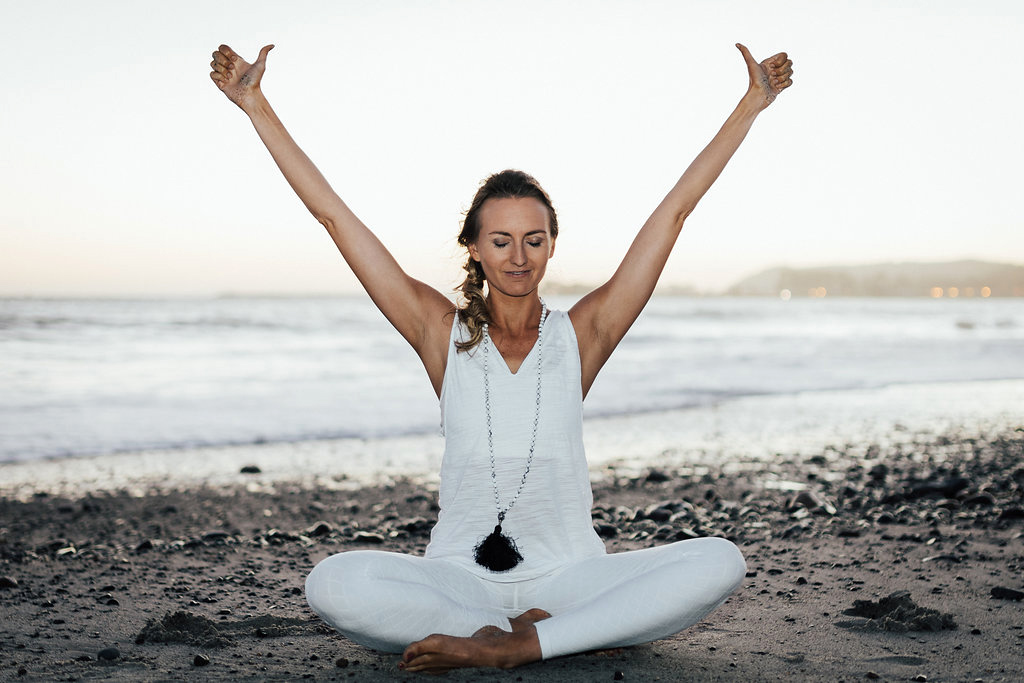
“What is the meaning of life?”
“How do I attain inner peace?”
“What is my true purpose?”
Many of us are constantly riddled with endless questions and challenges throughout our lives, which is why we often turn to yoga to reconnect with ourselves and the universe. In my experience, Sadhana is one of the most effective yoga practices you can embrace to “figure out the world and life “.
Through this article, I’ll be taking you on a journey of self-discovery and spiritual growth by tapping into the divine powers of Sadhana.
What does Sadhana mean in yoga?
The word “Sadhana” in Sanskrit means “methodical discipline to attain desired knowledge or goal”. Sadhana is built on the idea of daily spiritual practice—a committed prayer, a routine that you do for yourself to nurture your mind and body.
It is a common notion that yoga is something that takes up time and space—each asana needs to be held for 15-30 seconds, there has to be enough room for you to stretch, and most importantly, the ambiance has to be serene and stimulating. All these requirements sometimes pose a problem in keeping up with a daily routine.
But what if I told you that you are looking at it the wrong way—yoga is not the destination but the path—it is a tool that pauses time, expands your mind, and guides you into tranquility, despite all the chaos around. This is the basic principle of Sadhana—it helps you find the focal point of calm, anytime, anywhere.
The benefits of daily Sadhana are countless, making it an inevitable part of traditional Tantra and Kundalini yoga. Here are some of its major advantages:
- Foundation: Starting yoga Sadhana is similar to planting a seed—you nurture it every day, make sure it gets plenty of sunlight and water, and one day, it will grow into a huge tree under whose shade you will always find shelter.
- Discipline: Making Sadhana a daily practice will help you gain better control over your mind and body.
- Commitment: By taking a decision to practice Sadhana regularly, you are making a commitment to push your meditation practice to new boundaries.
- Evolution: Embracing Sadhana will help you break away from the mundane and become a better version of yourself with each passing day.
How many stages of Sadhana are there?
Tantra has recognized four stages of yoga Sadhana, namely, Murti Seva (idol worship), Japa and Stuti (chanting and incantation), Dhyana Dharana (meditation), and Brahma Sadhana (Cosmic Ideation). Each of these stages marks a level of progress.
Murti Seva (idol worship)
The first stage of Sadhana is idol worship. If you are a beginner, superimposing the image of your antaratma (conscience) onto something tangible, like an idol will help you focus better as you try to attain spiritual growth.
Japa and Stuti (chanting and incantation)
The second stage is characterized by chanting and incantation. This can be of three types—Vachanik (loud utterance of the name), Upanshu (utterance of the name in a low voice), and Mansik (utterance of the name in your mind). The first two types of Japa are considered mechanical to an extend, as chanting a name loudly repeatedly does not require concentration or self-awareness. But the third one probes you to visualize the Parama Purusha in your mind and channels your focus towards this ultimate goal.

Dhyana Dharana (meditation)
The next stage is Dhyana. This is a far superior version of yoga meditation compared to the first two stages. Here, you get one step closer to the supreme being with the power of enhanced concentration. This stage marks the endeavor to master self-awareness through discipline and determination.
Brahma Sadhana (Cosmic Ideation)
The final stage and the greatest challenge is Brahma Sadhana, the state of self-realization. This stage is considered the supreme stage of Sadhana, where you feel one with the supreme being via cosmic ideation and self-reflection.
How do I start a Sadhana practice?
According to Sadhguru, “Everything can be Sadhana.” It is not a particular aspect, rather, every aspect “The way you eat, the way you sit, the way you stand, the way you breathe, the way you conduct your body, mind and your energies and emotions,” he explains.
There are multiple means through which you can practice yoga Sadhana. Your primary objective should be to maintain regularity, so, it’s vital that you pick the practice that suits you the best. Here’s a simple roadmap to help you navigate through the sublime journey of Sadhana.
NOTE: These steps can be practiced independently or as a routine.
Asanas
Asana originally meant “seated posture” based on its Sanskrit roots meaning “seat”. But today, ‘Asana’ is a term commonly used to refer to any Hatha yoga posture, be it Vinyasa, Ashtanga, Restorative or Bikram. Asana practice is considered beneficial for both mental and physical health as each movement sparks life.
How: Begin your Sadhana with Hatha yoga. The term “Hatha” means forceful—when you are in an asana, your body, mind and soul are restricted to one place, forcing them to focus on staying still. I recommend three Hatha yoga poses that are ideal for a long-sitting Sadhana:
- Padma Asana (Lotus Pose)
- Swastika Asana (Auspicious Pose)
- Siddhasana (Accomplished Pose)
Here’s how asana practice can be beneficial for your physical and mental health:
- Increases flexibility and strength
- Stimulates the physiological systems in the body—immune, digestive, nervous, and circulatory
- Develops discipline
- Boosts mindfulness and concentration
- Opens the chakras and nadis in the body
Meditation
Meditation is a contemplative spiritual practice that helps you attain enlightenment. Though certain types of yoga meditation encourage you to let go of your thoughts, Sadhana meditation is anything but that. In Sadhana, you are expected to navigate through your innermost self and communicate with your spirit. Meditation is the cornerstone of an effective Sadhana session—it urges you, the practitioner, to concentrate better each time your train of thought wanders.
How: Once you are in an asana, the next step is to focus—channel your attention to a single aspect—the breath, a sound, or the image or concept of a cosmic being. Remember, the longer the asana, the deeper the meditation.
Here’s how taking up this challenge on a daily basis can improve mental health and willpower:
- Relaxes mind and body
- Makes you feel content
- Encourages to let go of ego
- Helps realize goals by improving focus and discipline
- Gives more control over actions, responses and reactions in life
- Intensifies personal and spiritual growth

Pranayama Breathing
Pranayama or Prana Sadhana is a set of personalized breathing exercises that can support and enhance your meditation. With each breath you take, these exercises increase the flow of energy in your mind, body and soul. Being a major pillar of Raja yoga, Pranayama helps promote better health with breath control alone.
How: Once you start meditation, establish a conscious connection with your breathing. Observe how your breath becomes one with the pulse of the universe. Feel each inhalation wash over you like a wave, and let go of all your mental and emotional blockage with every exhalation.
Here’s how breathing with an intention can change your life:
- Improves energy levels
- Helps manage stress better
- Cleanses and purifies the respiratory tract
- Enhances blood flow and nerve health
- Relieves stiffness and sluggishness
Mantras
Next comes mantra or chanting. A major challenge you might face when practicing Pranayama is the difficulty to keep your breathing consistent. This is where mantras come in. You can use a mantra to measure the length of each breath.
How: If you are a beginner, you can start with the most popular mantra—Om or the Aum. A few others you can memorize later are the Shanti Mantra, Gayatri Mantra and the Mangala Mantra. Repeat each chant at regular intervals and guide your breath according to the vibrations of your voice. Once you gain more experience, you can recite them softly or silently, depending on your level of comfort. Remember that pronunciation is key when it comes to mantra chanting. You can watch online tutorials or seek the help of a yoga teacher if you find it difficult to pronounce the words.
Chanting mantras every day can impact your life in numerous ways:
- Releases positive energy
- Soothes your mind and soul
- Decreases anxiety and symptoms of depression
- Elevates consciousness
Mudras

Mudras or hand gestures play a vital role in all types of yoga practices. Sadhguru defines mudra as “a seal”, literally translating it from Sanskrit. The way your systems function can be altered just by arranging your body in certain ways, and that’s what the subtle science of Mudras is all about. Each hand gesture can control the flow of energies and help you get one step closer to self-realization.
How: There are hundreds of mudras in yoga. While some are for health and well-being, the others are meant to stimulate certain processes in our bodies. Each type of yoga asana has a particular mudra associated with it and can make a world of difference when positioned right. Though it might seem like a challenge initially, with practice, you can learn to master all mudras.
Here’s a list of the most powerful yoga mudras that can enhance your Sadhana:
- Dhyana Mudra: Deepens your level of concentration
- Gyan Mudra: Enhances focus and memory power
- Buddhi Mudra: Boosts mental clarity
- Surya Mudra: Improves metabolism and digestion
- Shuni Mudra: Improves intuition, alertness, and sensory powers
- Prana Mudra: Helps awaken your prana (life)
- Apana Mudra: Aids mental and emotional digestion
Journaling
The final step of Sadhana is yoga journaling. The best way to keep track of self-awareness is by keeping a tangible record. Journaling can help hold on to the sudden moments of clarity you come across during meditation or the slight nuances you observe when practicing an asana. This can help you connect better with your mind and body. As a yoga teacher, I constantly record my experiences as it helps improve my form and aids in guiding my students better.
How: View your journal as a safe space where you can open your mind and be kind to yourself. Log your notes regularly to get a better picture of how far you have come along in the journey of Sadhana. Start simple, don’t overthink it. Think of the goals you aim to achieve, the small changes you keep noticing in your body, the way your thought process has shifted and how Sadhana is changing your life one day at a time.
Here’s how journaling expands your window of self-awareness :
- Helps clear your head
- Keeps track of everything you learn and discover
- Aids in identifying and correcting bad habits
- Enables you to practice gratitude and shed ego
I hope this article has given you a comprehensive understanding of the art of Sadhana and its benefits. Embrace it, practice it, master it, be one with—anything in the world will seem possible after that. Good luck!
Please leave a note in the comments section below if you have queries or thoughts regarding the information shared, I’ll be happy to help you out.
Take care and stay safe.
Next Steps
- If you’re interested in practical kriya yoga as a way to improve your daily life and relationships, check out my Yoga for Self Mastery course.
- Order my Yoga Life book for a practical guide to creating balance in your life through yoga.
- Check out my YouTube channel and find some yoga classes that you can try out for yourself!
Experience 3 Training Videos from Inside My 200-Hour Online YTT

YOU MIGHT ALSO LIKE
- What is Kriya Yoga? The Philosophy and Practice
- Uddiyana Bandha: Tapping Into Your Deep Core
- 4 Reasons Hasta Bandha Is Essential To Your Yoga Practice
- Vitarka Mudra: What It Is and How Do You Use It?
- Shakti Mudra: What It Is and How Do You Do It?
- Garuda Mudra: What It Is and How Do You Use It?
- Kali Mudra: What It Is and How Do You Do It?
- Shunya Mudra: What It Is and How Do You Do It?
- Varuna Mudra: What It Is and How Do You Use It?
- Vayu Mudra: What It Is and How Do You Use It?
- Samana Vayu: The Energy of Balance & How to Access It
- Apana Vayu: The Energy of Release & Surrender
- Udana Vayu: The Ascending Wind
- Prana Vayu: The Breath of Vitality
- Vyana Vayu: The Energetic Secret to Flow
Learn how to do 11 of the most popular yoga poses correctly. Free video + PDF download.











